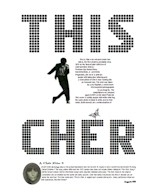
Last weekend I spent time with two friends on a trip partially to visit the Georgia O'Keeffe house in Abiquiu, New Mexico, something we all had tried to do back in March of 2020 but the pandemic started that weekend and the Georgia O'Keeffe Museum closed (which resulted in the creation of this thing).
This time we stayed at a guest ranch in Pojoaque, a place my family has been visiting for many years. Because I had been there before I was excited about taking a swim as soon as I arrived.
 Crossing the grassy lawn in my swimmies, with a towel under my arm and a big coke in my hand, I suddenly came upon this:
Crossing the grassy lawn in my swimmies, with a towel under my arm and a big coke in my hand, I suddenly came upon this:

Missing pool. Alarmingly missing pool.
Ten minutes later, while I was taking a very angry shower, I kept thinking "what does this remind me of? This reminds me of something."
And that's when it occured to me the missing pool, among a few other things that had delapidated a bit at the guest ranch, (the trail to the river was blocked by an ominous barricade of tumbleweeds), were reminding me of Sonny & Cher's cartoon visit to their honeymoon hotel with Scooby Doo. You know, the scene where Sonny is listing off all the amenities of the place (pool, tennis courts) and the caretaker is telling them all those things no longer exist?



Anyway, the guest ranch was not that bad but it was also not as good as previous visits either. Nevertheless, the weekend was beautiful; it rained most of the time through the cottonwoods and we hung out with peacocks, bullfrogs, goats, rabbits, burros and some very grumpy sheep while we had some deep conversations about life. We tried to feed the goats the day we left and they stole my friend's bowl from her hands and we had to stage a bowl rescue involving hanging her over the fence while the goats weren't looking. Good times.



Glamour shots of one of the bowl thieves.



Anyway, it just so happens my two friends are a gay couple and so we talked about recent (and possible upcoming) developments of the U.S. Supreme Court.
As a Cher fan, I have many gay men friends (and lesbian friends who are Cher fans too, as a matter of fact). Fag-hags was the derogatory term for us in the 80s. And all sorts of ideas proliferated about why we hung out with gay men, affection and shared interests never being part of the imaginative equations.
I was on a TV show once with a friend and many people thought we were depicted there as a gay couple there so Julie and I took to introducing the show to our new friends as Who Gets the Lesbians. (Edgar did. Edgar got the lesbians.) And although neither of us are gay, this never bothered me because it was actually more exciting than what was really going on in my life at the time; and if we had been gay, we would have been a very fun and interesting gay couple.
So for a long time I've been thinking about straight people in close relationships with gay friends. It should go without saying that having gay friends doesn’t mean you’re gay or on your way to being gay or that gay people are trying to turn you gay. Unfortunately, there are still folks out there who believe this.
 And this all came up again last week when Cher tweeted a birthday wish to Meryl Streep and recalled the swing scene from Silkwood.
And this all came up again last week when Cher tweeted a birthday wish to Meryl Streep and recalled the swing scene from Silkwood.
Although Silkwood is a very dry movie, (albeit one with an amazing cast), it's an unheralded example of a sweet relationship between straight and gay people. It depicts a very intimate and close relationship (one sometimes fraught with conflict) between Cher, who plays Dolly Pellicker, and Meryl, who plays Karen Silkwood, culminating very movingly in the swing scene: https://www.youtube.com/watch?v=XDP_4UqslnQ
While I was at the guest ranch, I also came across this news story about someone else I'm a fan of, "Barry Manilow pauses Newcastle concert after 'rude' reaction to lyric." Even though Barry Manilow is a gay man, most if not all of his fans are straight women, even ones like me who knew Barry was gay long before he came out.
According to the story, Barry Manilow was singing "Weekend in New England," and as he was singing "when will our eyes meet/when can I touch you" the girls in the audience started to holler.
The article states, "Looking slightly flustered, Barry was momentarily speechless, before letting out a little chuckle and commenting: 'My hands are busy now!'"
If you watch the video, the aforementioned pause is miniscule, the rudeness is questionable and the comeback is quick.

Barry is used to the sexual innuendos in his shows. The Concert at Blenheim Palace in 1983 is a good example of the Barry tease and screaming girls. I watched it recently in 'slight' amazement that it worked so well considering didn't half of us know he was gay? His repartee was full of double entendres and the girls sounded like they were losing their minds while their boyfriends sat there stoically trying to go to their happy places.
In "Weekend New England" most people miss the obvious sexuality and Barry performs the climax more lustfully than he gets credit for, which I assume is because he's become a performer most people assume has no sexuality. We love to rob people who are different or 'square' or a bit goofy of their sexuality.
“When will this strong yearning end…I feel brave and daring/I feel my blood flow."
Where did you think the blood was flowing?
It doesn’t matter that he’s now an outed gay man singing these lines to straight women. If Barry Manilow was caught off guard or flustered in Newcastle, (which I'm not convinced he was), maybe this was because he wasn't still expecting the straight reaction to his performance because it was occurring after he was outed; but the 'lewd' responses are still happening like clockwork.
And Barry Manilow is still responding with his old-school retorts. It's the very same thing, straight people in relationships with gay people and joking about sex and it gives me deep joy.
 Full disclosure: when I was eight years old, I found Sonny & Cher's final record at the local library. This album seemed totally crazy (even for an eight year old) and yet I still proceeded to develop a nine-minute dance routine to Sonny's confounding title opus.
Full disclosure: when I was eight years old, I found Sonny & Cher's final record at the local library. This album seemed totally crazy (even for an eight year old) and yet I still proceeded to develop a nine-minute dance routine to Sonny's confounding title opus.  Sonny's song is particularly venomous and disingenuous, full of bitterness. What's most shocking is that he got Cher to sing it.
Sonny's song is particularly venomous and disingenuous, full of bitterness. What's most shocking is that he got Cher to sing it. In contrast, Cher's fare-thee-well song to Sonny was Jimmy Webb's "Didn't We." Spectators to her performance of it, one of the final taped solos of the 1971-1974 series, say there wasn't a dry eye in the house, including Cher's.
In contrast, Cher's fare-thee-well song to Sonny was Jimmy Webb's "Didn't We." Spectators to her performance of it, one of the final taped solos of the 1971-1974 series, say there wasn't a dry eye in the house, including Cher's.






























































